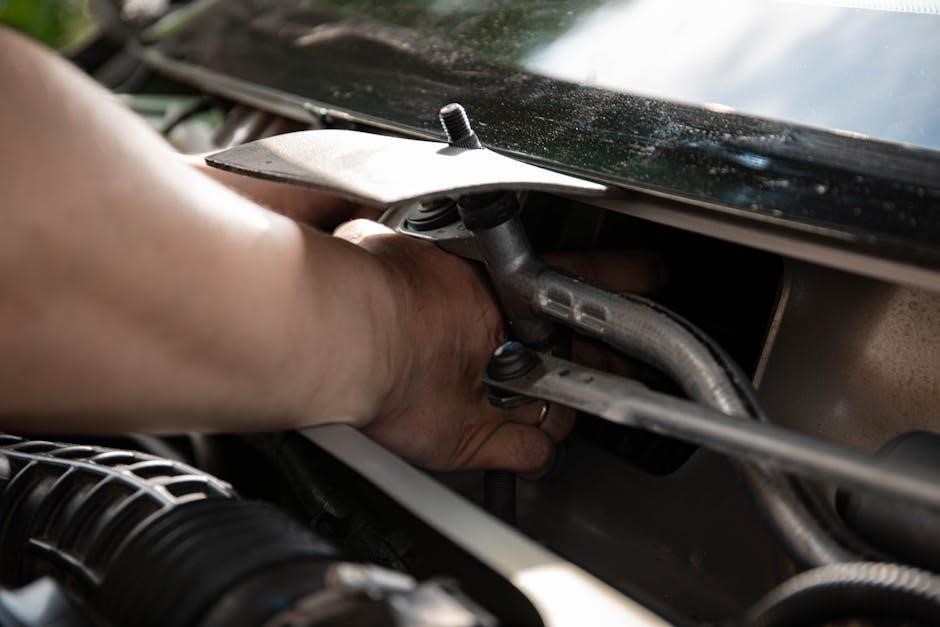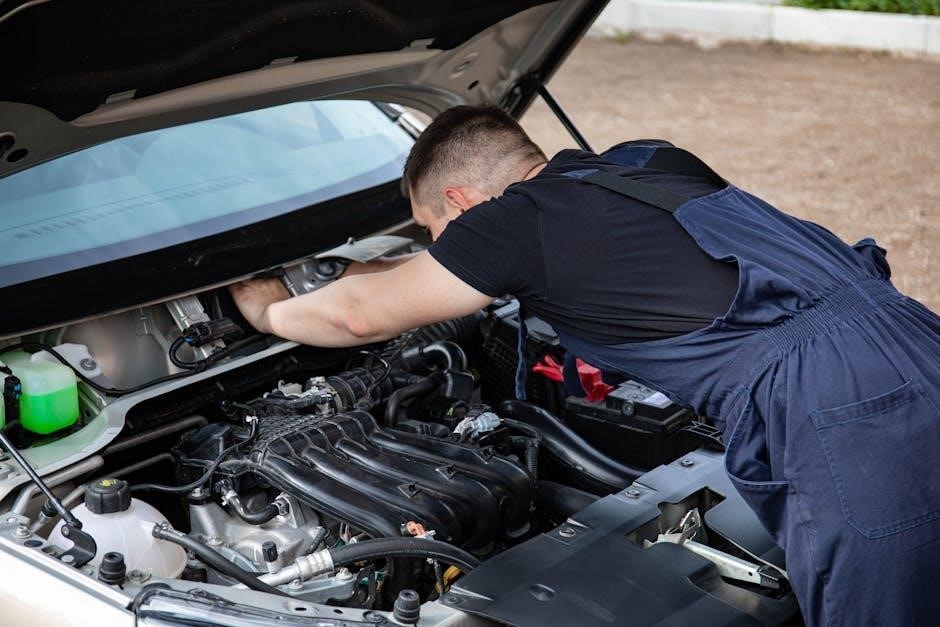The “Engine Idled See Manual Reset” message indicates a diesel engine issue‚ often due to sensor faults or low DEF levels‚ requiring immediate attention to restore performance and prevent damage․
1․1 Overview of the Issue
The “Engine Idled See Manual Reset” message typically appears in diesel engines‚ signaling a fault that forces the engine to idle․ This issue often stems from sensor malfunctions‚ low DEF levels‚ or DPF problems․ The engine may restrict performance to prevent damage‚ making it crucial to address promptly․ Ignoring this warning can lead to prolonged downtime or costly repairs․ Understanding the root cause is essential for effective troubleshooting and resetting the system․ This overview provides a foundation for diagnosing and resolving the issue‚ ensuring optimal engine operation and preventing further complications down the road․
1․2 Importance of Understanding the Problem
Understanding the “Engine Idled See Manual Reset” issue is crucial for maintaining engine health and preventing prolonged downtime․ Ignoring or misdiagnosing this problem can lead to costly repairs‚ reduced performance‚ or even engine damage․ Recognizing the root causes‚ such as faulty sensors or low DEF levels‚ enables effective troubleshooting․ Addressing the issue promptly ensures compliance with emissions standards and prevents further complications․ Additionally‚ understanding the problem helps in performing accurate resets and avoiding recurring issues․ This knowledge is essential for both professional technicians and vehicle owners to restore normal engine operation and maintain overall vehicle efficiency and reliability on the road․

Common Causes of “Engine Idled See Manual Reset”
The issue is commonly caused by faulty sensors‚ low DEF levels‚ DPF problems‚ or EGT sensor malfunctions‚ which disrupt normal engine operation and trigger the idle mode․
2․1 Faulty Sensors and Components
Faulty sensors‚ such as the Exhaust Gas Temperature (EGT) sensor or oxygen sensor‚ are primary contributors to the “Engine Idled See Manual Reset” issue․ These sensors provide critical data to the engine control unit (ECU)‚ and when they malfunction‚ the system may incorrectly interpret operating conditions․ For instance‚ a faulty EGT sensor can trigger forced idle mode to prevent overheating‚ while a defective oxygen sensor may disrupt emission controls․ Additionally‚ issues with the DEF sensor or DPF differential pressure sensor can also lead to this problem․ Ignoring these faulty components can result in prolonged idling‚ reduced performance‚ and potential long-term engine damage‚ emphasizing the need for prompt diagnosis and repair․
2․2 Low Diesel Exhaust Fluid (DEF) Levels
Low Diesel Exhaust Fluid (DEF) levels are a common cause of the “Engine Idled See Manual Reset” message․ DEF is essential for the selective catalytic reduction (SCR) system‚ which reduces nitrogen oxide emissions․ When DEF levels drop too low‚ the engine control unit (ECU) may limit engine performance to maintain emissions compliance․ This can result in reduced power‚ forced idling‚ or even engine shutdown․ Regularly checking and refilling the DEF tank is crucial to prevent this issue․ Ignoring low DEF levels can lead to more severe problems‚ such as increased emissions and potential damage to the SCR system‚ emphasizing the importance of prompt action to maintain engine functionality and performance․
2․3 DPF (Diesel Particulate Filter) Issues
A clogged or malfunctioning Diesel Particulate Filter (DPF) is another common cause of the “Engine Idled See Manual Reset” message․ The DPF captures soot and particulate matter from diesel engine emissions‚ but when it becomes saturated‚ it can trigger engine idle mode to protect itself․ If the DPF fails to regenerate properly‚ soot builds up‚ restricting exhaust flow and reducing engine performance․ Ignoring DPF issues can lead to increased emissions‚ reduced fuel efficiency‚ and potential damage to the filter or other components․ Regular DPF maintenance‚ including manual regeneration cycles‚ is essential to prevent this issue and ensure optimal engine operation․ Addressing DPF problems promptly helps avoid costly repairs and maintains engine efficiency․

Symptoms of “Engine Idled See Manual Reset”
Key symptoms include engine idling at low RPM‚ reduced power‚ and dashboard warning messages․ These indicators signal the need for immediate attention to prevent further engine damage․
3․1 Engine Idling at Low RPM
One of the primary symptoms of the “Engine Idled See Manual Reset” issue is the engine idling at low RPM‚ typically around 500-700 RPM․ This occurs when the engine management system detects a fault‚ forcing the engine into a reduced power mode to prevent damage․ Drivers may notice the engine running rough or struggling to maintain speed‚ especially when accelerating․ In some cases‚ the engine may stall or hesitate‚ further indicating the need for immediate attention․ This low idle condition is a critical warning sign that the system requires resetting or servicing to restore normal functionality and performance․
3․2 Reduced Engine Power
Reduced engine power is a common symptom accompanying the “Engine Idled See Manual Reset” message․ The engine may feel sluggish‚ with limited acceleration and a maximum speed restriction‚ often capping at 5 MPH․ This occurs when the system enters a limp mode to minimize potential damage․ Drivers may experience difficulty merging onto highways or climbing inclines‚ making everyday driving challenging․ The reduced power is a direct response to detected faults‚ such as sensor malfunctions or low DEF levels‚ signaling the need for prompt diagnostics and reset procedures to restore normal engine operation and prevent further complications․
3․3 Dashboard Warning Messages
Dashboard warning messages are a critical indicator of the “Engine Idled See Manual Reset” issue․ Common alerts include “Engine Idled ⸺ See Manual” or “Exhaust Fluid System Fault‚” signaling system malfunctions․ These messages often appear alongside specific error codes‚ such as P2085‚ linked to sensor or emissions-related problems․ The dashboard may also display notifications about reduced power or impending regeneration needs․ Such warnings are designed to alert drivers to take corrective action‚ such as resetting the system or addressing maintenance requirements․ Ignoring these messages can lead to prolonged limp mode operation‚ further complicating the issue and potentially causing additional damage to engine components․ Prompt attention is essential to resolve the underlying cause․

Resetting the Engine Idle System
Resetting the engine idle system typically involves specific procedures such as accelerator pedal resets‚ battery disconnects‚ or manual regeneration cycles‚ which vary by make and model․
4․1 Manual Reset Procedure
A manual reset typically starts with turning the ignition to the ON position without starting the engine․ Allow all warning lights to turn off‚ ensuring the system is ready․ Next‚ fully depress the accelerator pedal and hold it for about 10 seconds․ This step is crucial as it helps reset the throttle position sensor․ After releasing the pedal‚ start the engine and let it idle for a few minutes․ If issues persist‚ a manual regeneration cycle may be necessary․ Always refer to the specific vehicle’s manual for precise instructions‚ as procedures can vary by make and model‚ ensuring safety and effectiveness in resolving the idle issue․
4․2 Accelerator Pedal Reset Method
The accelerator pedal reset method is a straightforward process to address the “Engine Idled See Manual Reset” issue․ Start by turning the ignition to the ON position without starting the engine․ Once all warning lights have turned off‚ fully depress the accelerator pedal and hold it for approximately 10 seconds․ Release the pedal and immediately start the engine․ This procedure helps recalibrate the throttle position sensor and reset the idle system․ If the issue persists‚ repeating the process or combining it with other reset methods may be necessary․ Always ensure the vehicle is in a safe location before performing this procedure․ Consult the owner’s manual for specific instructions tailored to your vehicle․ This method is effective in many cases but may not resolve all underlying causes․ If problems continue‚ further diagnostic steps or professional assistance may be required to identify and address the root issue․ Regular maintenance and sensor checks can help prevent such issues from occurring in the future․ By following these steps carefully‚ you can restore normal engine operation and avoid potential damage․ Remember to monitor the dashboard for any recurring warning messages after completing the reset․ If the problem persists‚ it may indicate a more complex issue that requires specialized tools or expertise․ Always prioritize safety and follow proper procedures when working with engine systems․ This method is a quick and effective first step in resolving the “Engine Idled See Manual Reset” message‚ but it is important to address any underlying issues promptly to maintain optimal engine performance․ For persistent problems‚ consider consulting a professional mechanic or referring to the vehicle’s service manual for additional guidance․ By taking proactive steps‚ you can ensure your vehicle runs efficiently and avoid costly repairs down the road․ This simple reset procedure is a valuable troubleshooting tool for diesel engine owners and operators․ It is designed to help restore normal functionality and prevent unnecessary downtime․ Always remember to follow the recommended steps carefully to achieve the best results․ If you are unsure about any part of the process‚ seek assistance from a qualified technician to avoid complications․ This method is widely used and recommended by many diesel engine specialists as a first-line solution for idle-related issues․ By incorporating this procedure into your maintenance routine‚ you can help maintain your engine’s health and performance over time․ Stay informed about your vehicle’s systems and address issues promptly to ensure reliability and longevity․ This approach not only saves time but also helps prevent more severe problems from developing․ Keep your engine running smoothly by utilizing this effective reset method whenever the “Engine Idled See Manual Reset” message appears․ Remember‚ regular maintenance and prompt attention to warning messages are key to maintaining your vehicle’s optimal performance․ If you encounter any difficulties during the reset process‚ do not hesitate to consult additional resources or seek professional guidance․ Your vehicle’s performance and longevity depend on timely and effective solutions to such issues․ Always prioritize safety and follow established procedures when working with engine systems․ This method is a practical solution for many drivers facing the “Engine Idled See Manual Reset” issue‚ providing a clear path to resolving the problem efficiently․ By understanding and applying this procedure‚ you can take control of your vehicle’s maintenance and ensure it continues to perform at its best․ For ongoing issues‚ consider keeping a record of when the problem occurs and any steps taken to resolve it‚ as this information can be invaluable for further diagnosis․ Empower yourself with knowledge and take the first step toward resolving the issue with confidence․ This accelerator pedal reset method is a trusted approach for many vehicle owners and technicians alike‚ offering a straightforward solution to a common problem․ By staying proactive and informed‚ you can maintain your vehicle’s health and avoid unnecessary complications․ Remember‚ addressing issues promptly is essential for preventing more serious problems from arising․ This method serves as a reliable starting point for troubleshooting and resetting your engine’s idle system․ Use it wisely and keep your engine running smoothly for years to come․
4․3 Battery Disconnect Reset
The battery disconnect reset method is a reliable approach to resolve the “Engine Idled See Manual Reset” issue․ Start by turning off the engine and ensuring the vehicle is in park or neutral․ Disconnect both the positive and negative battery terminals to completely power down the system․ Wait for at least 10 minutes to allow the vehicle’s computer and powertrain control module to reset․ Reconnect the batteries and start the engine; This procedure clears temporary fault codes and resets the idle system․ If the issue persists‚ further diagnosis may be required․ Always perform this reset in a safe environment to avoid complications․ This method is effective for clearing forced idle mode caused by sensor or system glitches․ If the problem recurs‚ consult a professional to identify and address the underlying cause․ This simple yet effective technique can restore normal engine operation and prevent further issues․ Regular battery maintenance and system checks can help avoid such problems in the future․ By following these steps‚ you can quickly and safely reset the engine idle system and get back on the road․ This method is particularly useful when other reset procedures fail to resolve the issue․ Remember to monitor the dashboard for warning messages after completing the reset to ensure the problem has been fully addressed․ If the issue remains unresolved‚ additional troubleshooting or professional assistance may be necessary to identify and repair the root cause․ This approach is a valuable troubleshooting step for diesel engine owners and operators․ By disconnecting the batteries‚ you allow the vehicle’s systems to reset and recalibrate‚ often resolving the idle issue effectively․ Always prioritize safety and follow proper procedures when working with electrical systems․ This method is a straightforward solution for many drivers facing the “Engine Idled See Manual Reset” message‚ providing a clear path to resolving the problem efficiently; By understanding and applying this procedure‚ you can take control of your vehicle’s maintenance and ensure it continues to perform at its best․ For ongoing issues‚ consider keeping a record of when the problem occurs and any steps taken to resolve it‚ as this information can be invaluable for further diagnosis․ Empower yourself with knowledge and take the first step toward resolving the issue with confidence․ This battery disconnect reset method is a trusted approach for many vehicle owners and technicians alike‚ offering a straightforward solution to a common problem․ By staying proactive and informed‚ you can maintain your vehicle’s health and avoid unnecessary complications․ Remember‚ addressing issues promptly is essential for preventing more serious problems from arising․ This method serves as a reliable starting point for troubleshooting and resetting your engine’s idle system․ Use it wisely and keep your engine running smoothly for years to come․

Forced Idle Mode and Its Implications
Forced idle mode reduces engine power‚ causing slow acceleration and potential damage if not addressed promptly․ It signals underlying issues requiring immediate attention to prevent further complications․
5․1 Understanding Forced Idle Mode
Forced idle mode is a safety feature that restricts engine performance‚ typically triggered by emissions system faults or sensor issues․ During this state‚ the engine operates at low RPM‚ reducing power and speed to minimize emissions․ This mode is often indicated by dashboard warnings such as “Engine Idled” or “See Manual․” Drivers may experience limited throttle response and reduced acceleration․ Prolonged idling can lead to increased fuel consumption and potential damage to components like the DPF․ Understanding this mode is crucial for timely intervention and preventing further complications․ It is essential to address the root cause promptly to restore normal engine functionality․
5․2 Consequences of Prolonged Idling
Prolonged idling can lead to increased fuel consumption‚ reduced engine efficiency‚ and potential damage to components like the DPF․ Continuous low RPM operation may cause premature wear on engine parts‚ such as cylinders and piston rings․ Additionally‚ excessive idling can result in higher emissions‚ contributing to environmental impact․ If left unresolved‚ repeated idling episodes may require costly repairs‚ including DPF cleaning or replacement․ Furthermore‚ frequent idling can lead to increased maintenance visits‚ disrupting vehicle availability and productivity․ Addressing the root cause promptly is essential to avoid these long-term consequences and ensure optimal engine performance․

Role of Regeneration Cycles
Regeneration cycles clean the DPF by burning trapped soot‚ improving engine performance and reducing emissions․ Manual regen can resolve issues like forced idling‚ restoring normal operation․
6․1 Manual Regeneration Process
A manual regeneration process involves initiating a cleaning cycle for the DPF․ This is typically done by driving the vehicle at high speeds to generate sufficient heat․ Ensure the DEF tank is above 25% to prevent issues․ Start the engine‚ let it idle for a few minutes‚ then drive between 40-60 mph for 20-30 minutes․ The system will ignite the soot in the DPF‚ clearing blockages․ Avoid stopping or reducing speed during this process to ensure completion․ If successful‚ the “Engine Idled” message should clear‚ and normal operation resumes․ Always refer to the manual for specific instructions․
6․2 Impact on Engine Performance
The “Engine Idled See Manual Reset” issue significantly impacts engine performance‚ causing reduced power output and rough idling․ Prolonged idling can lead to increased fuel consumption and potential damage to components like the DPF․ If left unaddressed‚ the engine may enter a derated mode‚ limiting speed and torque․ This can result in decreased efficiency and difficulty maintaining consistent operation‚ especially under load․ Additionally‚ repeated regeneration cycles may cause temporary drops in performance․ It is crucial to resolve the issue promptly to avoid long-term damage and restore optimal engine functionality․ Ignoring the problem exacerbates wear on critical systems‚ potentially leading to costly repairs․

Clearing Codes and Error Messages
Clearing codes and error messages requires diagnostic tools like OBD-II scanners‚ Forscan‚ or Autel devices․ These tools help identify and reset fault codes‚ resolving the “Engine Idled” issue effectively․
7․1 Using OBD-II Scanners
An OBD-II scanner is a essential tool for diagnosing and clearing codes related to the “Engine Idled See Manual Reset” issue․ By connecting the scanner to the vehicle’s OBD-II port‚ you can retrieve specific fault codes that triggered the idle mode․ Once the codes are identified‚ the scanner allows you to clear them‚ potentially resolving the issue․ Some advanced scanners also support bi-directional communication‚ enabling functions like forcing a regeneration cycle or resetting the idle system․ Regularly using an OBD-II scanner helps maintain engine health and prevents recurring problems․ Always ensure the scanner is compatible with your vehicle’s make and model for accurate results․
7․2 Forscan and Autel Tools
Forscan and Autel tools are advanced diagnostic devices used to address “Engine Idled See Manual Reset” issues․ These tools enable users to clear complex fault codes and reset systems beyond basic OBD-II capabilities․ Forscan‚ in particular‚ is favored for its compatibility with Ford vehicles‚ allowing manual regeneration cycles and deep system resets․ Autel tools provide similar functionality‚ offering advanced troubleshooting for emission-related issues․ Both tools are highly effective in resolving persistent idle problems and forced idling modes․ By leveraging these devices‚ technicians can bypass lengthy procedures and directly address root causes‚ ensuring a quicker resolution to engine idle issues․ Regular use of Forscan and Autel tools helps maintain optimal engine performance and prevent recurring problems․
TSB (Technical Service Bulletin) 14-0192
TSB 14-0192 addresses the “Engine Idled See Manual Reset” issue‚ providing specific procedures to resolve forced idling․ It outlines steps to clear fault codes and reset systems effectively․
8․1 Purpose of the Bulletin
TSB 14-0192 aims to address persistent “Engine Idled See Manual Reset” messages by outlining diagnostic and repair procedures․ It focuses on resolving issues related to forced idle modes‚ ensuring proper engine operation and emissions compliance․ The bulletin provides detailed steps for technicians to identify root causes‚ such as faulty sensors or low DEF levels‚ and reset systems․ By following the guidelines‚ technicians can effectively clear error codes and restore normal engine functionality‚ minimizing downtime and preventing further complications․ This bulletin is particularly relevant for vehicles equipped with diesel engines‚ where idling issues are common due to emission control systems․
8․2 Application in Resetting Idle Issues
TSB 14-0192 provides specific instructions for resolving persistent “Engine Idled See Manual Reset” messages․ It outlines a step-by-step process to reset the system‚ including clearing fault codes using Forscan or Autel tools․ The bulletin recommends driving the vehicle under specific conditions to complete the reset‚ ensuring the engine operates normally․ If issues persist‚ it advises disconnecting the battery to reset the engine control module․ This approach helps technicians diagnose and resolve idle-related problems efficiently‚ ensuring compliance with emissions standards and restoring proper engine functionality․ By following TSB 14-0192‚ technicians can address the root cause of idle issues and prevent future occurrences․

Preventive Maintenance Tips
Regular DEF tank checks‚ monitoring sensor health‚ and ensuring proper DPF regeneration can prevent “Engine Idled See Manual Reset” issues‚ maintaining optimal engine performance and efficiency․
9․1 Regular DEF Tank Checks
Regularly inspecting the Diesel Exhaust Fluid (DEF) tank ensures adequate levels‚ preventing low DEF-related issues that trigger “Engine Idled See Manual Reset” messages․ Always use high-quality DEF to avoid contamination‚ which can damage sensors and the SCR system․ Check for leaks or damage to the DEF tank‚ lines‚ and injectors‚ as these can cause unexpected DEF level drops․ Monitoring DEF consumption rates helps anticipate refills‚ especially during long trips or heavy-duty operations․ Proper storage and handling of DEF are crucial to maintain its effectiveness and prevent crystallization‚ which can disrupt engine performance and lead to forced idle modes․ Regular DEF tank checks are a simple yet effective preventive measure․
9․2 Monitoring Sensor Health
Monitoring the health of sensors is critical to preventing “Engine Idled See Manual Reset” issues․ Faulty sensors‚ such as the EGT (Exhaust Gas Temperature) or oxygen sensors‚ can trigger forced idle modes․ Regularly check for sensor contamination‚ damage‚ or malfunction‚ as these can disrupt engine performance․ Use diagnostic tools like Forscan or Autel to scan for error codes related to sensor faults․ Clean or replace sensors as needed to ensure accurate readings․ Neglecting sensor health can lead to persistent idling problems‚ reduced power‚ and repeated error messages․ Addressing sensor issues early helps maintain engine efficiency and avoids costly repairs down the line․ Regular sensor checks are a key part of preventive maintenance;

Troubleshooting Steps
Check for fault codes using OBD-II scanners or tools like Forscan and Autel to identify underlying issues․
Test sensor functionality to ensure accurate readings and diagnose potential malfunctions․
10․1 Checking for Fault Codes
Utilize an OBD-II scanner to retrieve fault codes‚ which provide insights into the engine’s condition․ Codes like P2085 or oxygen sensor-related issues may appear‚ guiding further diagnostics․ Ensure the tool is compatible with your vehicle’s system․ Review the codes to identify specific malfunctions‚ such as sensor failures or exhaust system faults․ This step is crucial for pinpointing the root cause of the “Engine Idled See Manual Reset” message․ By understanding the codes‚ you can address the problem effectively‚ whether it’s a DEF level issue or a faulty component needing replacement․ Accurate code interpretation is key to resolving the idle problem․
10․2 Testing Sensor Functionality
To diagnose the “Engine Idled See Manual Reset” issue‚ test sensor functionality using an OBD-II scanner or specialized tools like Forscan․ Monitor live data from sensors such as the Exhaust Gas Temperature (EGT) and oxygen sensors‚ which are often faulty․ Check for erratic or out-of-range readings that may trigger the idle mode․ Physically inspect sensors for damage or corrosion․ Ensure the Diesel Exhaust Fluid (DEF) sensor is functioning correctly‚ as low DEF levels can cause similar symptoms․ If a sensor fails testing‚ replace it and clear the codes to verify if the issue persists․ Addressing faulty sensors early prevents further engine complications․

When to Consult a Professional
Consult a professional if the “Engine Idled See Manual Reset” issue persists after resets or if complex diagnostic scenarios arise‚ ensuring proper resolution and preventing further damage․
11․1 Persistent Issues After Reset
If the “Engine Idled See Manual Reset” issue recurs despite attempts to resolve it‚ further investigation is necessary․ Persistent problems may indicate underlying faults such as faulty sensors‚ defective components‚ or unresolved DPF issues․ In such cases‚ a professional mechanic should be consulted to perform a comprehensive diagnostic check․ They can identify and address root causes effectively‚ ensuring the problem is resolved permanently․ Delaying professional intervention could lead to more severe engine damage and increased repair costs․ A skilled technician will have the tools and expertise to pinpoint the issue accurately‚ providing a reliable solution to restore your engine’s performance and functionality․ Always seek professional help if self-reset attempts fail to resolve the issue‚ as prolonged idling can compromise engine health and operational efficiency․
11․2 Complex Diagnostic Scenarios
Complex diagnostic scenarios involving “Engine Idled See Manual Reset” often require advanced troubleshooting techniques․ These situations may involve multiple fault codes‚ inconsistent symptoms‚ or underlying issues not immediately apparent․ Specialized tools like Forscan or Autel scanners are essential for decoding and analyzing deep-level faults․ In some cases‚ manual regeneration or forced idle resets may not resolve the issue‚ indicating a need for professional intervention․ Mechanics with expertise in diesel systems can perform in-depth diagnostics‚ such as testing sensor functionality or inspecting the DPF‚ to identify and repair complex problems․ These scenarios highlight the importance of advanced diagnostic skills and tools to address persistent or unclear issues effectively․ Always consult a professional if self-diagnostic efforts are unsuccessful․




